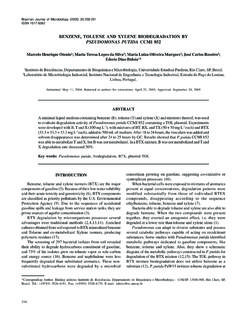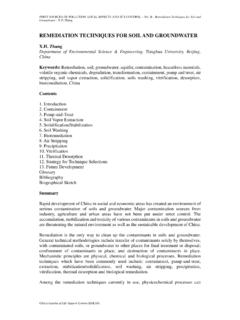Transcription of Bioremediation: An Overview
1 BIOTECHNOLOGY Vol. X -- bioremediation : An Overview - M. Vidali bioremediation : AN Overview . M. Vidali Dipartimento di Chimica Inorganica, Metallorganica, e Analitica, Universit di Padova Via Loredan, Padova, Italy Keywords: bioremediation , Contamination, hazardous, monitoring, excavation, remediation, dechlorination Contents 1. Introduction 2. Principles of bioremediation TE SS. 3. Factors of bioremediation 4. Microbial Population for bioremediation Processes S. 5. Environmental Factors R. Nutrients AP L. Environmental requirements H O. 6. bioremediation Strategies In situ bioremediation C E. Ex situ bioremediation Advantages of bioremediation E O . Disadvantages of bioremediation 7. Phytoremediation Acknowledgements Glossary PL C. Bibliography Biographical Sketch M ES.
2 Summary SA N. A brief outline of the development of bioremediation technologies is presented. U. The major features and limitations are discussed, and an Overview of the current state of the art in field applications is sketched. 1. Introduction The quality of life on Earth is linked inextricably to the overall quality of the environment. In early times, we believed that we had an unlimited abundance of land and resources; today, however, the resources in the world show, in greater or lesser degree, our carelessness and negligence in using them. The problems associated with contaminated sites now assume increasing prominence in many countries. Contaminated lands generally result from past industrial activities when awareness of the health and environmental effects connected with the production, use, and disposal of hazardous substances were less well recognized than today.
3 The problem is worldwide, and the estimated number of contaminated sites is significant. It is now widely recognized that contaminated land is a potential threat to human health, and its continual discovery over Encyclopedia of Life Support Systems (EOLSS). BIOTECHNOLOGY Vol. X -- bioremediation : An Overview - M. Vidali recent years has led to international efforts to remedy many of these sites, either as a response to the risk of adverse health or environmental effects caused by contamination or to enable the site to be redeveloped for use. The conventional techniques used for remediation have been to dig up contaminated soil and remove it to a landfill, or to cap and contain the contaminated areas of a site. The methods have some drawbacks. The first method simply moves the contamination elsewhere and may create significant risks in the excavation, handling, and transport of hazardous material.
4 Additionally, it is very difficult and increasingly expensive to find new landfill sites for the final disposal of the material. The cap and contain method is only an interim solution since the contamination remains on site, requiring monitoring and maintenance of the isolation barriers long into the future, with all the associated costs and potential liability. TE SS. A better approach than these traditional methods is to completely destroy the pollutants S. if possible, or at least to transform them to innocuous substances. Some technologies R. that have been used are high-temperature incineration and various types of chemical AP L. decomposition ( , base-catalyzed dechlorination, UV oxidation). They can be very H O. effective at reducing levels of a range of contaminants, but have several drawbacks, principally their technological complexity, the cost for small-scale application, and the C E.
5 Lack of public acceptance, especially for incineration that may increase the exposure to contaminants for both the workers at the site and nearby residents. E O . bioremediation is an option that offers the possibility to destroy or render harmless various contaminants using natural biological activity. As such, it uses relatively low- cost, low-technology techniques, which generally have a high public acceptance and can PL C. often be carried out on site. It will not always be suitable, however, as the range of contaminants on which it is effective is limited, the time scales involved are relatively M ES. long, and the residual contaminant levels achievable may not always be *Lecture presented at the 8th International Chemistry Conference in Africa (8th ICCA), 30 July.
6 4 August 2001, Dakar, S n gal. Although the methodologies employed are not SA N. technically complex, considerable experience and expertise may be required to design and implement a successful bioremediation program, due to the need to thoroughly U. assess a site for suitability and to optimize conditions to achieve a satisfactory result. Because bioremediation seems to be a good alternative to conventional clean-up technologies research in this field, especially in the United States, rapidly increasing. bioremediation has been used at a number of sites worldwide, including Europe, with varying degrees of success. Techniques are improving as greater knowledge and experience are gained, and there is no doubt that bioremediation has great potential for dealing with certain types of site contamination.
7 Unfortunately, the principles, techniques, advantages, and disadvantages of bioremediation are not widely known or understood, especially among those who will have to deal directly with bioremediation proposals, such as site owners and regulators. Here, we intended to assist by providing a straightforward, pragmatic view of the processes involved in bioremediation , the pros and cons of the technique, and the issues to be considered when dealing with a proposal for bioremediation . Some tests make an exhaustive examination of the literature of Encyclopedia of Life Support Systems (EOLSS). BIOTECHNOLOGY Vol. X -- bioremediation : An Overview - M. Vidali bioremediation of organic and inorganic pollutants, and another test takes a look at pertinent field application case histories.
8 2. Principles of bioremediation Environmental biotechnology is not a new field; composting and wastewater treatments are familiar examples of old environmental biotechnologies. However, recent studies in molecular biology and ecology offer opportunities for more efficient biological processes. Notable accomplishments of these studies include the clean-up of polluted water and land areas. TE SS. bioremediation is defined as the process whereby organic wastes are biologically S. degraded under controlled conditions to an innocuous state, or to levels below R. concentration limits established by regulatory authorities. AP L. H O. By definition, bioremediation is the use of living organisms, primarily microorganisms, to degrade the environmental contaminants into less toxic forms.
9 It uses naturally C E. occurring bacteria and fungi or plants to degrade or detoxify substances hazardous to human health and/or the environment. The microorganisms may be indigenous to a E O . contaminated area or they may be isolated from elsewhere and brought to the contaminated site. Contaminant compounds are transformed by living organisms through reactions that take place as a part of their metabolic processes. Biodegradation of a compound is often a result of the actions of multiple organisms. When PL C. microorganisms are imported to a contaminated site to enhance degradation we have a process known as bioaugmentation. M ES. For bioremediation to be effective, microorganisms must enzymatically attack the pollutants and convert them to harmless products.
10 As bioremediation can be effective SA N. only where environmental conditions permit microbial growth and activity, its application often involves the manipulation of environmental parameters to allow U. microbial growth and degradation to proceed at a faster rate. Like other technologies, bioremediation has its limitations. Some contaminants, such as chlorinated organic or high aromatic hydrocarbons, are resistant to microbial attack. They are degraded either slowly or not at all, hence it is not easy to predict the rates of clean-up for a bioremediation exercise; there are no rules to predict if a contaminant can be degraded. bioremediation techniques are typically more economical than traditional methods such as incineration, and some pollutants can be treated on site, thus reducing exposure risks for clean-up personnel, or potentially wider exposure as a result of transportation accidents.













